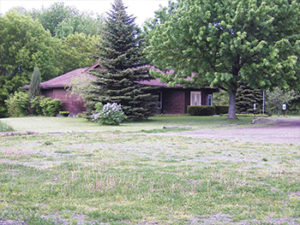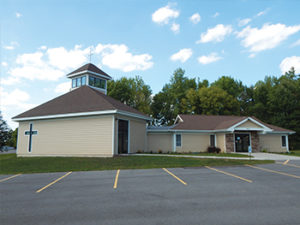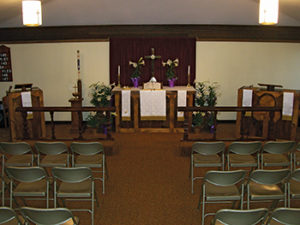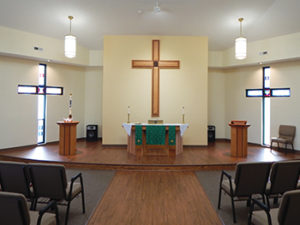Renovation: Liverpool, New York
“Was this a house before it became a church?” “Isn’t that a dentist’s office?” “I didn’t know there was a church there.” Back in 2005 when we restarted Cross of Christ as a mission, one of the biggest challenges was establishing a community identity. After ten years without a full-time pastor, the congregation’s identity in the community was that they worshiped in a very small, dark brown building set far back from the road with a giant maple tree towering over it. To those in WELS circles, we were striving to re-establish our identity in the community while maintaining a classic 1981 WEF unit that still had the original orange carpet.
A Practical Concept with Unintended Consequences
During the boom years of planting missions back in the 1970s and 1980s, a WEF facility (Worship-Education-Fellowship) was the typical “next step” for WELS mission congregations when they transitioned from rented space to their first permanent space. At the time, the WEF unit was a practical concept that was intended to be a flexible “starter” facility for missions which would expand their multi-purpose building as they grew. Unfortunately in many cases, this practical concept had unintended consequences.
WEF congregations often found themselves saddled with debt, which hindered timely expansion. This often resulted in the “starter” church unintentionally becoming permanent and future phases being put on the back burner. Because they were intended as transitional buildings, WEF units were not typically designed with the best quality. They became difficult to maintain after years, even decades, of wear and tear from multi-purpose usage. As congregations grew, the WEF unit’s size, typically under 2,100 sq. ft., often limited the available space for growth and flexibility in worship, education, and other areas of ministry. In fact, it was not unusual for a mission congregation to already be outgrowing its WEF by the time the facility was dedicated. As you can imagine, restarting a mission with an aging WEF unit was going to be a challenge.
The Need for Space
Some improvements provided a clearer identity to our community that benefited our outreach efforts: clearing trees, repainting the building white with brown trim, and paving the parking lot. But these improvements did not address the key weakness of a WEF unit—available space for worship, education, outreach, and other areas of ministry in a growing congregation. Within five years of the restart, it became clear that an expansion and renovation of the facility was desperately needed. Whenever attendance reached 60-70, our gathering space and musical space diminished considerably. One Easter Sunday the choir had to stand in the back corner tucked around the organ and piano since there was no other room to stand. Fellowship after worship, which played a key role in post-worship contacts with guests, required breaking down a sizable portion of the worship space to make room for standing and chatting over refreshments with scant room for tables and chairs for seating. During the late spring through fall, this issue could be somewhat relieved if people stepped outside, but winters in Central New York can be harsh when large amounts of snow descend on the area.
Our study committee sought an approach that we described as “Lutheran flexibility.”
As the Lord blessed our mission efforts and with these increasing challenges in mind, Cross of Christ formed a study committee in 2011 to determine what we would need to do to expand and renovate our WEF facility for a growing congregation. We determined that we needed “a clearly defined and liturgically-themed sanctuary that has some flexibility for other uses, with the WEF being converted into multi-purpose ministry space.” At the same time, we were mindful of the fact that our budget would be limited. As we discussed the concept that we would present to potential architects, our study committee sought an approach that we described as “Lutheran flexibility.” This would be demonstrated in the design of a dedicated worship space, which focused worshipers on the cross and on the means of grace with font, altar, and ambo, while providing flexible seating for 150-200 using interlocking chairs. The worship space would be designed with an emphasis on “beauty in simplicity” with natural light built into the design—a necessity in our area especially in winter. More adequate space would be provided at the rear for musicians, instruments, and choir. The WEF unit would be converted to flexible education, fellowship, outreach, and gathering space, while needed offices and storage would be part of the link between the buildings. Most importantly, we wanted our finished facility to clearly and unmistakably identify us as a Christ-centered church in our community. Thankfully the Lord provided a local architect, who was willing and able to work with us to develop our concept, even though ours was the first church he ever designed.
We wanted our finished facility to clearly and unmistakably identify us as a Christ-centered church.
Three years of ups and downs, challenges and blessings, passed before shovels went in the ground for our expansion and renovation. Unexpectedly high costs for the original design and some confusion with the financing led to downsizing that design and a one-year delay on the project. That extra time, however, allowed us to gain valuable knowledge in an architectural design that beautifully emphasizes the use of the means of grace while providing flexible functionality for all areas of ministry. In late 2014, with financing approved, Builders for Christ1 came onboard to assist us with renovating our WEF and adding 2,600 sq. ft. of worship and office space. Upon that approval, sub-committees were formed to make decisions for the interior of the sanctuary, the interior of the renovation, the exterior of the building, and for construction.
More Than We Imagined
We broke ground on Easter Sunday 2015 and work went quickly. What resulted from all that planning and studying and deciding and building was breathtaking for everyone who knew the former facility.

Exterior before
Our original worship space was a rectangular box with tight aisles and metal folding chairs that typically seated 50-60 people and no more than 80. Our new sanctuary fans out around the main focal point of the raised chancel area. Rows of flexible interlocking chairs provide seating for 90 with room for up to 150+. The wide aisles and the increased space between seating rows provides much more freedom and flexibility of movement, especially for families with young children.
Our original worship space had four narrow windows that provided limited natural light. Our new sanctuary is bathed in natural light from a large 10’x10’x10.5’ cupola that opens above the center of the sanctuary at the peak of the roofline drawing your eyes heavenward as you walk into the sanctuary. Twelve 4’ tall windows ring the cupola providing natural light at all times of day. At the rear of the sanctuary a set of 10’ tall windows brings in the morning light and allows passers-by to see into our sanctuary. Probably the most unique feature that brings in natural light is the two 9’x6’ cross windows that stand on either side of the raised chancel area. Both were originally installed with frosted glass, but a member with training in stained glass design is creating panels that will be installed on the interior side of the windows. During the day natural light shines through them into our sanctuary. At night, both cross windows are lit up from the inside for the passing public to see. Even during construction, the visible cross windows were the most recognized aspect of our design that people in our community have mentioned.2
At night, both cross windows are lit up from the inside for the passing public to see.

Exterior after
Our original worship space had small pendant lights hanging from an elevated ceiling in one half of the main room, while the back half had fluorescent lights in a dropped ceiling. The new sanctuary is much more well-lit and balanced with its lighting. Two rows of tall pendant lights follow the seating line towards the chancel area. Two pendant lights above the chancel area shine directly above the ambo and the font on either side of the altar drawing the eye to these symbols of the means of grace. An LED directional light shines on the large wooden cross hanging on the back wall of the chancel. Bronze-colored wall sconces ring the sanctuary with indirect light and LED strip lighting provides indirect light upwards from the base of the cupola. This new lighting design proved to be particularly powerful during our Tenebrae service on Good Friday as the different sets of lights were dimmed during the service, while one single light shone on the cross at the end of the service.
Our approach to chancel area design was “beauty in simplicity” with a clear emphasis on what God accomplishes through the means of grace.

Interior before
The chancel area of our original worship space was set tight against one wall at the end of the main room. There was limited space for liturgical movement largely due to the amount of furniture in that space—a very wide pulpit, a sizable lectern and altar, a font that was not part of the original set, and a set of unwieldy communion rails that had been donated from another church. During the Christmas season, the space shrunk even more with the addition of a Christmas tree. The new chancel is spacious and allows for easy movement from ambo to free-standing altar to font—even during the Christmas season and even with the construction of a small sacristy at the back of the chancel. During construction, the decision was made to eliminate communion rails from the chancel area due to certain space needs. This decision was welcomed by elderly members since it was difficult for them to kneel for the Lord’s Supper in our previous sanctuary.
Our approach to chancel area design was “beauty in simplicity” with a clear emphasis on what God accomplishes through the means of grace. WELS artisans Charis Carmichael Braun and her husband Andrew assisted with the design of chancel furnishings that are both modern and timeless with a prominent ambo and font stand3 that frame the free-standing altar. A Waterford crystal bowl serves as the baptismal font with the paschal candle on a dark wood stand behind the font. Behind the free-standing altar hangs the primary focal point of our new sanctuary—a 9’ tall cross made of white oak with dark walnut inlay matching the other furnishings which were created by Bill and Helen Rose of Builders for Christ. Wood colors were chosen to set off the vivid liturgical colors of the paraments. The center cross is framed by the two cross windows serving as a visual reminder of the three crosses on Golgotha, while also serving as a visual reminder of the triune God. The center window in the cross on the left has an open hand that symbolizes God the Father, while the center window in the cross on the right has a dove that symbolizes the Holy Spirit. The center cross serves as a reminder of what Christ accomplished on the cross.

Interior after
Our original worship space had fair acoustics. Years before the restart, the ceiling over the primary worship space was raised using dry wall, but a dropped ceiling remained at the rear of the worship space. Being such a relatively small space for a congregation that has always enjoyed singing, poor acoustics could be overcome, although the farther back you sat, the worse the sound got. The piano and organ were also located in the back corner of the room. After the dry wall went up, we discovered how live our sanctuary was with its 12’ high walls, elevated ceiling, concrete flooring, and fanned-out angles. For people sitting on either side of the sanctuary, there was even a noticeable delay, and our elderly members had difficulty hearing due to the reverb. For flooring we selected luxury vinyl tile with a wood grain finish over the raised chancel area and for the large center aisle from the chancel area to the entrance of the sanctuary. Under the seating area, high-grade commercial carpeting was installed. The flooring materials combined with the interlocking seating provided just enough control of the acoustics to provide a reasonable balance for sound—both musical and spoken.
We did not have a functional sound system in the original sanctuary. With the new sanctuary, a basic sound system was installed, piping sound to a new cry room and classroom area, and we began using an over-the-ear mic. We also installed an Audio Induction Loop System to provide clear sound for people with T-coil equipped hearing aids. We continue to tweak our sound system and have plans to expand our live streaming capabilities. A dedicated “organ nook” was created at the rear of the sanctuary. We also received the gift of a new Yamaha upright piano to replace one that had served for many years in the original worship space.
The interior of our original facility was rather dark with lots of dark oak or dark wood trim and finish. So the expanded and renovated facility was intentionally brightened up with light colors in every room. In the new gathering area, which used to be the rear of the main WEF room, the dropped ceilings were raised with new indirect lighting hung from the ceiling brightening up the entire room. New commercial carpeting replaced the original orange carpeting. The new larger gathering area is now a bright and pleasant space that serves a variety of purposes from fellowship after worship to education and meeting space at other times throughout the week.
With the assistance of Builders for Christ, kitchen space was redesigned to be more open while providing twice as much cabinet and countertop space and new appliances. Classroom space went from temporary dividers set up around tables in the back of the WEF to a new classroom area where the former chancel used to be. While the main entryway remained the same size, it was redesigned to improve the flow of traffic for adults and children. New storefront doors with large window panes replaced doors that had very narrow windows and allowed very little light. Ceramic tile replaced aging linoleum in the entryway. Around the exterior of the original WEF doorway a member installed a beautiful stonework design. A 6’ white cross stands atop the cupola and is visible for all who travel past our busy intersection.
A Clear Identity
Seven months after groundbreaking we celebrated the dedication of our new facility along with the fortieth anniversary of our founding. This writer enjoyed seeing the “Wow!” reactions of so many friends and former members who remembered the original facility and were amazed at what they saw the Lord had accomplished. It was a most joyful event with nearly 150 people joining us for our celebration—and every one of them fit comfortably in our new sanctuary.
In the year that has passed since our dedication, we have had many opportunities to chat with neighbors in our community. No longer do we find the confusion that people had years before. Our neighbors know who we are. They had watched as our new building went up and they were generally pleased to see it happen. People have pulled into the parking lot just to look at the crosses. We always tell them it’s even more beautiful on the inside. While buildings shape who we are, we pray that this new building clearly identifies who we are in Christ—his people gathered around Word and water and meal and sent out to take the saving message of Christ crucified to our world.
Written by Jeremiah J. Gumm
Jeremiah has served at Cross of Christ in Liverpool, New York since he graduated from Wisconsin Lutheran Seminary in 2005. He currently serves also as secretary of the North Atlantic District and as a member of the seminary’s Pastor Partners Mentoring Leadership Team.
Additional pictures are available at http://worship.welsrc.net/download-worship/worship-the-lord-renovation-projects/.
1 www.kingdomworkers.com/buildersforchrist.php
2 The cross windows were a late addition, suggested by a member at a Q&A session during our pre-building Capital Campaign.
3 The matching design of the font stand and the base of the ambo was inspired by the font at Calvary in Dallas, TX presented in the March 2007 issue of Worship the Lord. worship.welsrc.net/download-worship/wtl-church-architecture/
The Wittenberg Psalter
A new way of singing psalms is available for free download at worship.welsrc.net. This collection features resources for celebrating the 500th anniversary of the Reformation and beyond. It uses the concept of “formulary tones” (as developed by Paul Bunjes) to set psalm texts to music derived from Reformation-era chorale tunes, many by Martin Luther. The texts are identical to those in Christian Worship, but without refrains. The composer, Steven J. Rhode, states: “The Wittenberg Psalter is a collection of unison psalm settings for congregation, choir, and/or soloist.” He recognizes that—due to perceived difficulty—they “may not be appropriate for every congregation” and provides various options for usage. Be sure to read “About the Wittenberg Psalter,” provided by the composer.
[fbcomments num=”5″]


